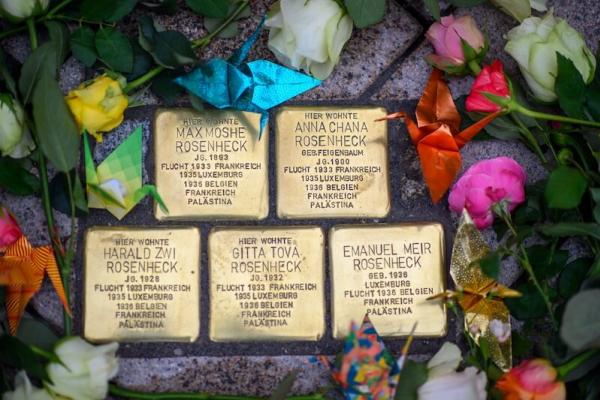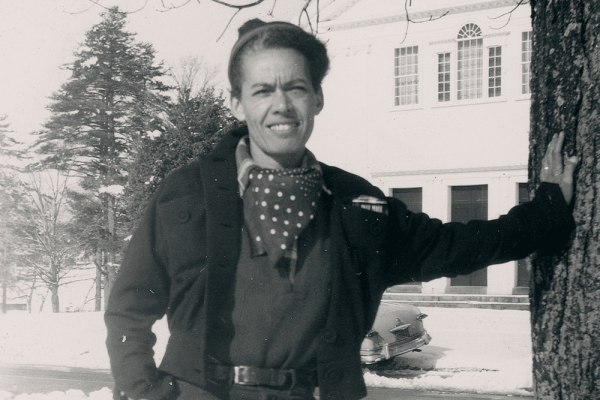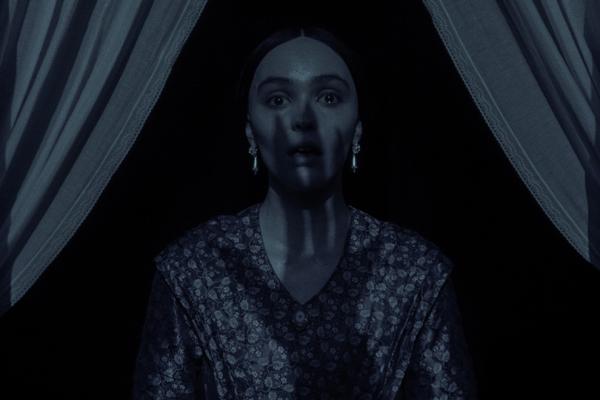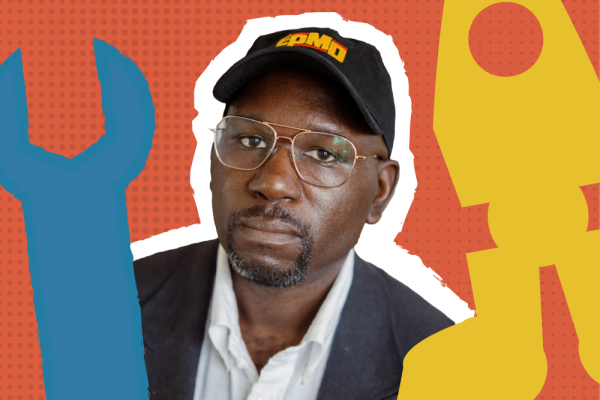Across Germany, you will find small, raised stones topped with copper on sidewalks. Engraved on these stones are names, addresses, and dates. These Stolpersteine, or stumble stones, memorialize victims of the Holocaust. The Stolpersteine rest in front of the last known homes and businesses of those who were murdered by the Nazis or fled Nazi persecution. Emerging out of German memory culture in the 1990s after reunification, these memorials are designed to “trip you” — metaphorically speaking. Jutting up along the sidewalk, they are existential speed bumps, forcing you to slow down just enough to encounter a historical memory.
Currently, I am going through the process of placing stumble stones for numerous Jewish family members in the Mitte borough of Berlin. This memorial process kindled a curiosity regarding how Christians and churches in my family’s neighborhood responded to the emergent and growing fascism of Nazi Germany. In 1930, one of the initial groups of Nazi pastors was founded nearby. In 1933, when Hitler was appointed as chancellor, the neighboring and venerable St. Mary’s Church celebrated. There, 2,000 worshipers participated in a “service of thanksgiving” and heard pastor Joachim Hossenfelder describe the new chancellor as “the best man imaginable … a man who was all of a piece, cast of purity, piety, energy and strength of character, our Adolf Hitler.”
After the Nazi electoral victory, there was a surge in church attendance (with one church district claiming an 1,800 percent increase in church membership). Many took this as a sign that a “spiritual awakening” was breaking out and church leaders declared it a joyous “ecclesiastical event” or “God’s hour.” Indeed, Hitler’s promise that Nazism was a “moral” political movement and that the new Reich would “extend its strong, protecting hand over Christianity as the basis of our entire morality and the family” seemed to be coming true.
In 1935, across the river from where my family lived, the Nazi-run parliament unanimously passed the Reich Citizenship Law. A deepening of the already emerging racial regime, this law categorized who was a German citizen, initially stripping those of Jewish descent of their citizenship. Proof of Aryan descent became essential to maintain or gain citizenship, and this was done primarily through both ancestral birth certificates and ecclesial baptismal records. This use of sacramental records meant that, according to historian Kyle Jantzen, “Churches became the most important site for the implementation of Nazi racial segregation.”
With their citizenship stripped from them and sensing the deadly direction Germany was headed, my great-grandmother acquired forged baptismal certificates and the family fled. Initially escaping to Palestine, they eventually made their way to the U.S. I was raised Christian. But I still struggle with this, now being a part of the faith that inflicted displacement upon my family. I lack a coherent emotional grasp of this story, but I can feel the rough shape of the loss. That loss is unexpectedly present, something I stumble over. But in this stumbling is a small, personal grace that has transformed my faith, bringing me to worship a God who is not simply for the oppressed but engages in the work of liberation.
In my upbringing, the Christian contours of the Third Reich were not named. Instead, the Christianity of the Nazis was elided as neo-pagan, atheistic, or at the most, an opportunistic adoption of Christian symbols. I mostly encountered narrow hagiographies of the Confessing Church, which oversold its role as a Protestant resistance movement to the Nazi regime. But scholarship over the last 30 years from historians such as Susannah Heschel, Kyle Jantzen, Robert Michael, and Richard Steigmann-Gall has unsettled the idea that Nazism and “true” Christianity were completely separate.
Nazism was not a uniform movement, but Christian communities provided the active acquiescence and support (theological, material, and institutional) that was essential in helping fascists capture and wield power. Furthermore, significant portions of German Christians understood Nazism as a Christian political movement that would build a Christian state, and many prominent Nazis understood their party to be a Christian party.
Fascism was not sustained by German Christians being forced into a political project they knew to be evil, but in the religious belief that they were engaging in a holy and true embodiment of their faith. Fascism’s velocity builds upon what is already present.
Indeed, the political priorities and language of Nazism strike a chord in the current landscape of U.S. politics. Fascists lamented the weak and “godless [Weimar] republic” and argued that “German-Christian culture” was at stake. Rejecting “Christian cosmopolitanism,” they hoped ethnic solidarity and “heroic piety” would enable a “re-Christianization of state and society,” bringing about a moral and political revival. Hitler was held as a quasi-messianic figure and Jesus Christ was held up as the “embodiment of all manliness.” German women were to build the Christian family by laboring in the domains of the home and heart. All of this was bound together with hatred of their enemies; Nazi-supporting German Christians were anti-Marxist, anti-liberal, and antisemitic.
What was true of Nazi-supporting German Christians is true of many right-wing Christians in the U.S. today. For example, white evangelicalism generally and the New Apostolic Reformation specifically serve as the theological, electoral, and affective core of the resurgent tide of U.S. fascism. Whether it is their xenophobic responses to migrants, criminalizing queer and trans people, gutting public goods for the “undeserving,” or relishing in joyous license to oppress while often longing to establish a racist theocracy, right-wing Christians’ ethnonationalistic political hopes and actions are deadly. However, they believe their political theology is a faithful embodiment of the god they worship and serve.
German liberation theologian Dorothee Soelle sought to understand just how Christians came to enable and actively support fascist political projects. When she reflected on the Christian Right in the 1970s and ’80s — and specifically televangelist Jerry Falwell Sr.’s Old Time Gospel Hour television show — she saw how conservative evangelicals’ dedication to a “politics of strength” set the stage for a “Christofascist religion.” Later, she simply called the Christian Right of this time period “Christofascist.” In her familiarity with Nazism, she saw that the Religious Right was of the same root and branch as the Third Reich.
The Christofascists of today do not view themselves as existing outside Christianity, but it can be said that they worship a different god: the god of the plantation, concentration camps, prisons, punishing your enemies, apartheid, and genocide. Again, Soelle says as much, stating that in the Religious Right, she saw “a God without justice, a Jesus without a cross, an Easter without a cross—what remains is a metaphysical Easter Bunny in front of the beautiful blue light of the television screen, a betrayal of the disappointed, a miracle weapon in service of the mighty.”
Their political objectives reveal the god of Christofascism as a god of death, a god who proclaims a gospel of counterfeit life while feasting upon life itself. Within this god’s political project, being a good Christian makes you a good fascist. Fascistic movements play out differently across cultures, history, denominations, and nations, but Christian communities and institutions have been supportive and are frequently the core constituency of fascistic movements and regimes. The global movement of fascism has only grown since Soelle coined this term, and one could argue that Christofascism is a majority tradition within Western fascism. Fascism, more often than not, is Christofascism.
But Christianity is not inherently fascistic, and faithful worship of the God of liberation means that churches are called to operate as anti-fascist institutions. There is a dual horizon to this necessary calling.
First, we must build power to accomplish the near-term defeat of Christofascist movements. Beyond securing necessary electoral victories (e.g. defeating national and local proto-fascist politicians), it means ending xenophobic and militaristic “solutions” to mass migration, providing networks of safety and care for those subjected to fascistic suppression, protecting and expanding abortion rights, fighting anti-trans legislation, shifting municipal and state budgets away from policing, and building union density and power. There is grace in ensuring that fascistic dreams cannot become more of a reality.
Secondly, we must imagine a more expansive political horizon — working to abolish all that gives fascism its velocity. This work of abolition requires historically contextualizing the Holocaust by placing it within the racial and economic order built by Christian supremacy, whiteness, colonial imperialism, and capitalism. The horrifying consummations of this order are manifest in the eliminationist objectives of the Holocaust but also in the exploitation of chattel slavery, the dispossession and border regimes of colonial empires, and the apartheid terror of the Jim Crow South.
Within this history, Christofascism is an implanted crisis that will recur again and again unless there is an intervention. That is to say that the social and economic conditions of our current order that created Christofascism are not timeless, unchangeable truths. So long as these underlying conditions persist, Christofascism will continue to erupt from within the church and white Christians will remain dependable fascistic allies. Only by acting to transform society and our political economy — organizing and building a racial, economic, and political democracy — can we disrupt the conditions that feed Christofascism.
Faithful worship of the God of liberation involves laboring for these two interwoven political horizons. The God of life calls us to protect life by resisting Christofascism’s near-term political goals and focusing on the long-term goal of nurturing a world and a faith where Christofascism itself becomes impossible.
While the artifacts of my family’s forged baptismal certificates are lost, the legacy of my family’s actions remains. In this forgery was a life-giving truth, something truer than the “authentic” baptismal certificates of their Christian neighbors; my family’s faithfulness surpasses that of their neighbors who worshiped as pastor Hossenfelder praised Hitler in the vaunted sanctuary of St. Mary’s in 1933. My family’s forgeries and lies were sacraments of life, a testament to the God who is on the side of life.
Got something to say about what you're reading? We value your feedback!







